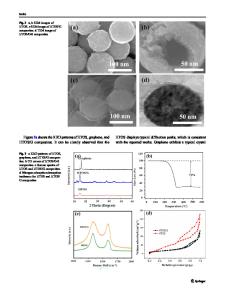Electrochemical behavior study of carbon nanofiber/MnO 2 composites as sulfur host for highly effective polysulfide abso
- PDF / 928,558 Bytes
- 6 Pages / 595.276 x 790.866 pts Page_size
- 30 Downloads / 396 Views
ORIGINAL PAPER
Electrochemical behavior study of carbon nanofiber/MnO2 composites as sulfur host for highly effective polysulfide absorbent Shoufa Liu 1 & Dancheng Liu 2 & Xun Qiao 1 Received: 3 September 2020 / Accepted: 18 September 2020 # Springer-Verlag GmbH Germany, part of Springer Nature 2020
Abstract The practical application of lithium-sulfur batteries is mainly hindered by the rapid capacity fading, which is caused due to the polysulfide shuttle effect and poor electronic conductivity of sulfur cathode. Therefore, it is urgent to enhance the electrochemical performance of Li-S battery via improving the polysulfide migration and inhibit the polysulfide shuttle effect. In this study, carbon nanofiber/MnO2 composites are prepared and designed as host materials for sulfur. Due to the synthetic effect of high electronic conductivity and strong adsorption for polysulfide, the as-prepared carbon nanofiber/MnO2@S (CNF/MO@S) composites exhibit initial high specific capacity of 1286 mAh g−1 at 0.1 C. Besides, the CNF/MO@S composites show specific capacity of 786 mAh g−1 after 200 cycles at 2 C. Keywords Cathode . Shuttle effect . Polysulfide . Cycling stability . Specific capacity
Introduction To meet the requirements for high energy density devices, many energy storage systems have been studied [1], including lithium-ion batteries [2–4], lithium-sulfur batteries [5–7], and lithium-air batteries [8, 9]. Among these various energy storage devices, lithium-sulfur batteries are one of the most promising candidates due to their high specific capacity and energy density, which are much higher than the traditional lithiumion batteries [10, 11]. Besides, the cathode active material sulfur is abundant and friendly to the environment [12]. Therefore, lithium-sulfur batteries have drawn much attention for the researchers all over the world. However, there are still some problems that hinder the commercialization of lithiumsulfur batteries [13]. First, the poor electron conductivity of
Electronic supplementary material The online version of this article (https://doi.org/10.1007/s11581-020-03789-x) contains supplementary material, which is available to authorized users. * Shoufa Liu [email protected]; [email protected] 1
School of Mechanical Engineering, ijing University, Xi’an 710123, People’s Republic of China
2
Xi’an Space Engine Co. Ltd., Xi’an 710100, People’s Republic of China
sulfur restrained the capacity release of active materials of the cathode [14]. Second, the shuttle effect of soluble polysulfide caused rapid capacity fading during the electrochemical cycles [15]. Third, the pulverization of lithium anode also led to poor cycling stability of lithium-sulfur batteries [16]. To overcome the above obstacles, great efforts have been paid to modify the electrochemical performance of lithiumsulfur batteries [17]. On the one hand, the researchers enhanced the electronic conductivity via using carbon materials as hosts, including carbon nanofiber [18], carbon nanotube [19], and graphene [20]. On the othe
Data Loading...











